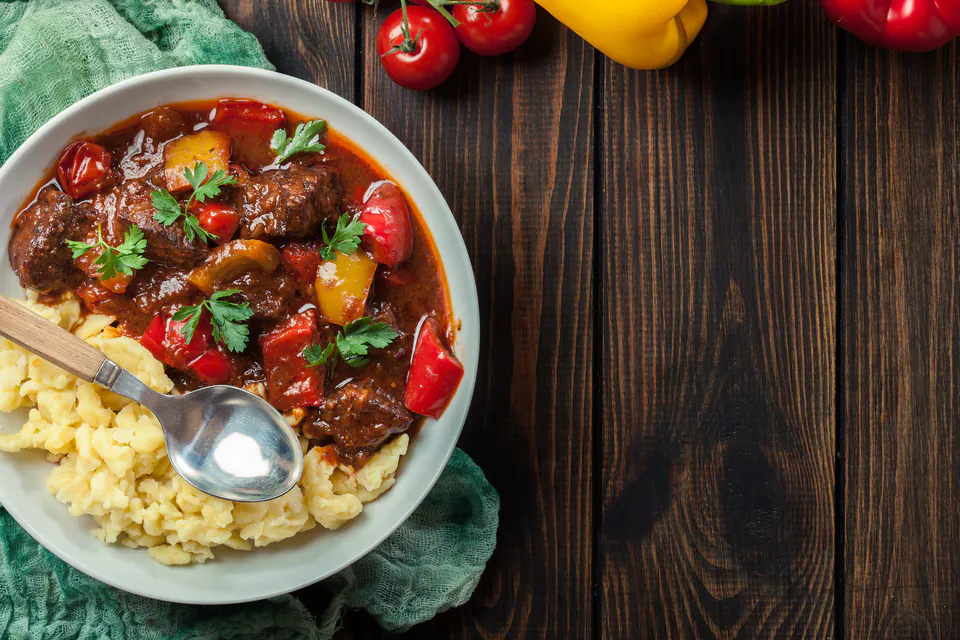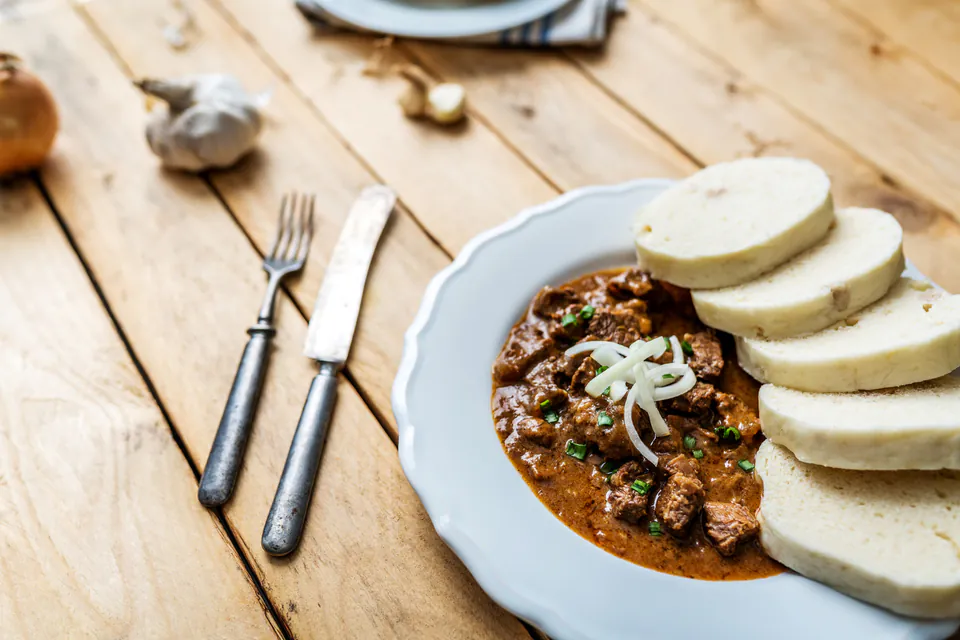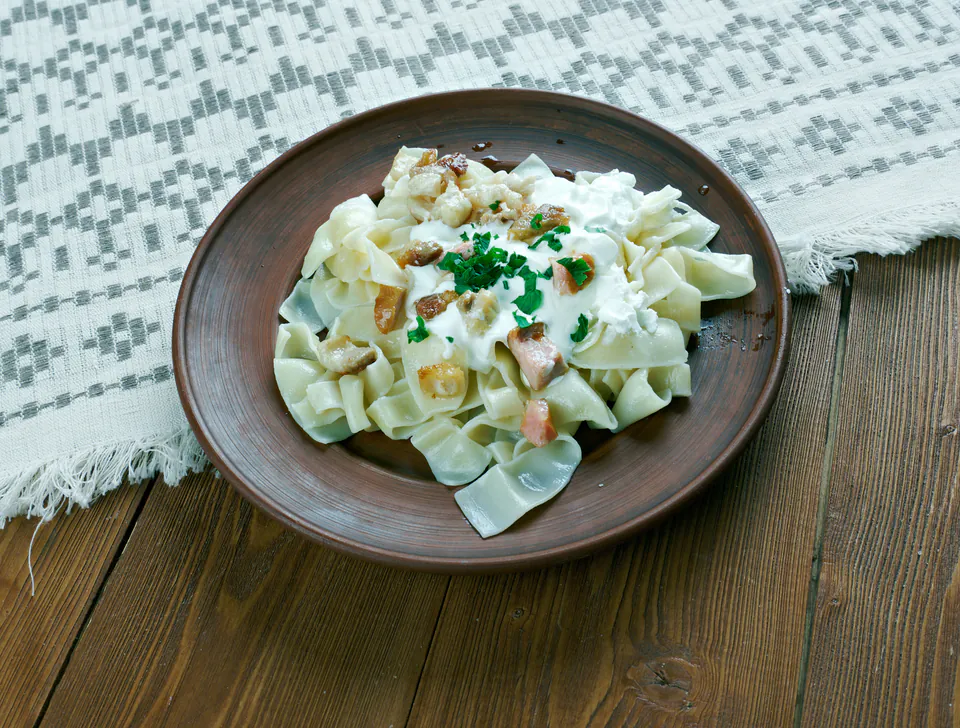Essential Hungarian Dishes and Food Culture in Budapest
When we first arrived in Budapest, we had no idea what to expect from Hungarian food. Turns out, this city has some seriously amazing dishes that tell the whole story of Hungary through every bite. The food here mixes old peasant cooking with fancy coffeehouse culture, and trust us, it's incredible.
What makes Hungarian food special is paprika. This red spice came through Ottoman trade routes way back and completely changed how Hungarians cook. You'll see it everywhere, from sweet and mild to crazy hot. Mix that with sour cream, good meat, and fresh vegetables, and you get the base for Hungary's best dishes.

The Must-Try Hungarian Dishes
Gulyás (Goulash) - The Real Deal
Real Hungarian goulash is nothing like what you might have tried elsewhere. We learned this pretty quickly when we ordered our first bowl in Budapest. Authentic gulyás is actually a soup, not some thick stew. They cook it slowly in these cast-iron pots called bogrács over open fires, just like cattle herders did back in the day.
You start with good beef (chuck or shoulder works great), brown it with onions, then add that amazing Hungarian paprika. This turns everything bright red. Then you throw in potatoes, carrots, tomatoes and let it all simmer. The slow cooking makes all the flavors come together perfectly.
The paprika is what makes it special. Hungarian cooks use sweet paprika (édesnemes) and hot paprika (csípős), sometimes both together. This dish actually comes from "gulyás hús" which means herdsmen's meat. It became a big symbol of Hungarian identity back in the 1800s.

Csirkepaprikás (Chicken Paprikash) - Pure Comfort
If goulash is the bold cousin, chicken paprikash is the gentle, comforting one. We always order this when we want something creamy and warming. It's chicken pieces cooked in this amazing orange-red sauce that gets its color from sweet paprika and its creaminess from sour cream.
You brown the chicken first (thighs and drumsticks work best), cook some onions until golden, add paprika off the heat so it doesn't burn, then put the chicken back with some broth. Right before serving, you stir in sour cream to make it super creamy.
They serve it with nokedli, these little egg dumplings that are like German spätzle. The dumplings soak up all that creamy sauce perfectly. This is Hungarian home cooking at its best.
Lángos - Street Food Heaven
You can't visit Budapest without trying lángos. This is the city's most famous street food, and once you try it, you'll understand why locals are obsessed. It's basically deep-fried flatbread that puffs up when it hits the hot oil.
The dough is simple (flour, yeast, water, salt), but when you drop it in hot oil, magic happens. It gets crispy outside and stays soft and fluffy inside. The classic way to eat it is with garlic sauce or butter, sour cream, and grated cheese.
We've seen all kinds of crazy toppings now (Nutella, ham, sausage), but honestly, the classic version is still the best. We made the mistake of trying fancy versions first, but nothing beats the original.

Töltött Káposzta (Stuffed Cabbage) - Winter Comfort
Stuffed cabbage is serious comfort food. These are cabbage leaves wrapped around a filling of minced pork, rice, and spices, then cooked slowly in a tangy sauce. It takes forever to make, but it's so worth it.
You have to blanch big cabbage leaves until they're soft enough to roll, then fill them with this mixture of ground pork, rice, onions, and paprika. The rolls go in a pot with sauerkraut and sometimes smoked bacon. Everything cooks together for hours.
This dish is huge during winter and holidays. Many families think you have to have it at Christmas and New Year's for good luck. Always comes with sour cream, which cuts through all that tangy sauerkraut.
Kürtőskalács (Chimney Cake) - Sweet Street Treat
Walking around Budapest, you'll smell these before you see them. Chimney cake is this unique pastry that looks as good as it tastes. They wrap sweet dough around cone-shaped spits and roast it over charcoal.
While it bakes, they brush it with butter and roll it in sugar, which caramelizes and gets crispy. The inside stays soft and warm. It's called kürtőskalács because it looks like a stovepipe.
Traditional toppings are cinnamon and ground walnuts, but now you can get chocolate, coconut, almonds, all kinds of stuff. We still think the classic cinnamon version is the best though.

Halászlé (Fisherman's Soup) - Seriously Spicy
If you like spicy food, halászlé will test your limits. This bright red soup made from river fish and tons of hot paprika is probably the spiciest thing in traditional Hungarian cooking.
They use a mix of river fish like carp, catfish, perch, and pike. First they make a rich stock from fish bones, strain it, then season with sweet and hot paprika. The result is this crazy red broth that's sweet from the fish but seriously hot from the paprika.
Different regions make it differently. The Szeged style uses multiple fish and has a smooth broth, while Baja style focuses on carp and adds homemade pasta. Both versions will definitely wake up your taste buds.
Regional Dishes Worth Trying
Hortobágyi Palacsinta - Fancy Crêpes
Despite the name, this dish was actually created for the 1958 Brussels World Fair to show off Hungarian cuisine. It's thin Hungarian crêpes filled with seasoned meat stew and covered in creamy paprika sauce.
The filling is usually minced veal or chicken cooked with onions and paprika. You fill the crêpes, fold them, then top with sauce that tastes like chicken paprikash. Finish with sour cream and herbs.
Túrós Csusza - Simple but Amazing
This humble dish shows how Hungarians can make simple ingredients taste incredible. It's egg noodles with túró (Hungarian curd cheese), sour cream, and crispy bacon bits. Sounds basic, but it's so good.
The secret is good quality túró, which is like farmer's cheese or cottage cheese. When you mix it with warm noodles and sour cream, it gets creamy. The bacon adds that smoky, salty flavor that makes everything better.

Sweet Stuff and Desserts
Dobos Torta - Layer Cake Perfection
The Dobos torta is like the ultimate Hungarian layer cake. József C. Dobos created it in 1885, and it's got thin sponge cake layers with chocolate buttercream, topped with hard caramel.
What was cool about this cake was that it lasted longer than other cakes, which was revolutionary back then. The buttercream was unusual for the 1800s, and that hard caramel top helped keep it fresh. The sides have ground nuts for extra texture.
This cake got famous after Emperor Franz Joseph I and Empress Elisabeth tried it at a Budapest exhibition. It became a symbol of Budapest's fancy coffeehouse culture.
Lecsó - Vegetable Goodness
While Hungarian food is known for meat, lecsó shows they know how to do vegetables too. This colorful stew has sweet Hungarian wax peppers, ripe tomatoes, and onions. It's like summer in a bowl.
You cook onions until golden, add sliced peppers, then finish with tomatoes and paprika. The vegetables cook down into this thick, flavorful stew. You can eat it plain or add sausage or eggs. It's a great way to use up garden vegetables.

Where to Find the Best Hungarian Food
Traditional Restaurants
Budapest has these traditional restaurants called csárdas that give you the real Hungarian experience. They usually have rustic décor, live folk music, and menus with recipes that have been around forever.
Some places specialize in certain dishes. We found restaurants that focus on perfect goulash, while others do amazing game meats or fish. The atmosphere feels like rural Hungary, with wooden furniture, traditional ceramics, and servers in folk costumes.
Street Food and Markets
Budapest's street food scene is where you can try Hungarian flavors without sitting down for a formal meal. Street vendors and market stalls have fresh lángos, grilled sausages, and chimney cakes.
The Great Market Hall is the center of Budapest's food culture. Vendors serve traditional dishes alongside fresh produce and artisanal products. The second floor food courts are where locals grab lunch and visitors can try multiple dishes in one spot.
Modern Takes on Traditional Food
These days, Budapest restaurants are doing modern versions of traditional Hungarian dishes. They might serve deconstructed goulash, gourmet lángos with weird toppings, or fancy presentations of classic desserts.
We love how modern Hungarian chefs respect traditional flavors but use contemporary techniques. They often get ingredients from specific regions known for quality, like Mangalica pork or special varieties of paprika.

Hungarian Food Culture Basics
Why Paprika is Everything
Paprika isn't just seasoning in Hungarian cuisine. It's what makes Hungarian food different from neighboring countries. The spice came during Ottoman times and gradually became essential to Hungarian cooking.
Hungarian paprika varies a lot in heat and flavor. Sweet mild varieties get used in everyday cooking, while fiery hot versions add serious heat to dishes like halászlé. The quality and where it comes from can completely change how a dish tastes. The best paprika comes from places like Szeged and Kalocsa.
How Seasons Affect the Food
Hungarian cuisine follows the seasons, which makes sense given the country's farming heritage. Summer brings fresh vegetables for dishes like lecsó. Autumn has game meats and mushroom dishes. Winter is all about hearty stews and preserved foods. Spring celebrates fresh herbs and early vegetables.
These seasonal patterns still influence Budapest's dining scene. Restaurants change their menus to highlight ingredients when they're at their best. Traditional preservation methods like smoking, pickling, and curing are still important.
How Hungarians Eat
Hungarian dining culture is all about hospitality and taking time with meals. Lunch is traditionally the main meal, often with multiple courses including soup, main dish, and dessert. Dinner tends to be lighter, though restaurants have adapted for international visitors.
Bread is important in Hungarian meals, often served with every course and sometimes charged separately in restaurants. Sour cream shows up a lot, both as an ingredient and condiment, providing cooling contrast to paprika-spiced dishes.
Essential Hungarian Dishes Guide
| Dish | Type | Key Ingredients | Serving Style |
|---|---|---|---|
| Gulyás (Goulash) | Soup | Beef, paprika, onions, potatoes | Hot with bread |
| Csirkepaprikás | Main Course | Chicken, paprika, sour cream | With nokedli dumplings |
| Lángos | Street Food | Fried dough, sour cream, cheese | Fresh and hot |
| Töltött Káposzta | Main Course | Cabbage, pork, rice, sauerkraut | Hot with sour cream |
| Kürtőskalács | Dessert | Sweet dough, sugar, cinnamon | Warm from the spit |
| Halászlé | Soup | River fish, hot paprika, onions | Hot with bread |